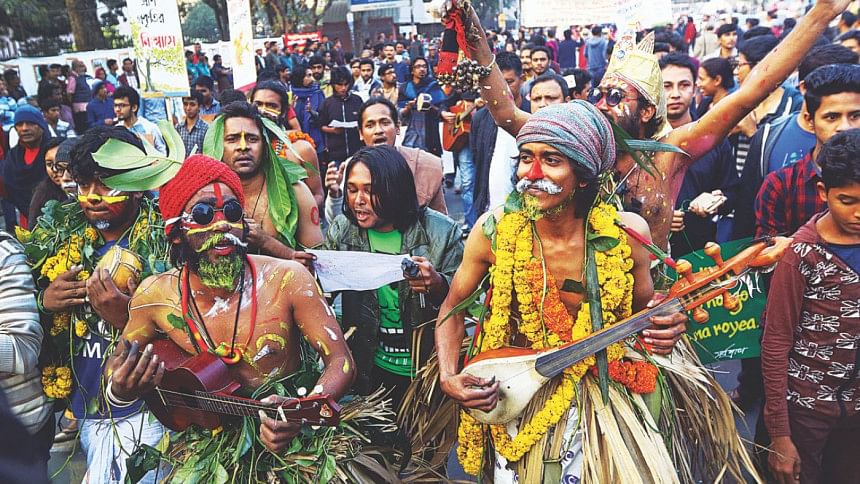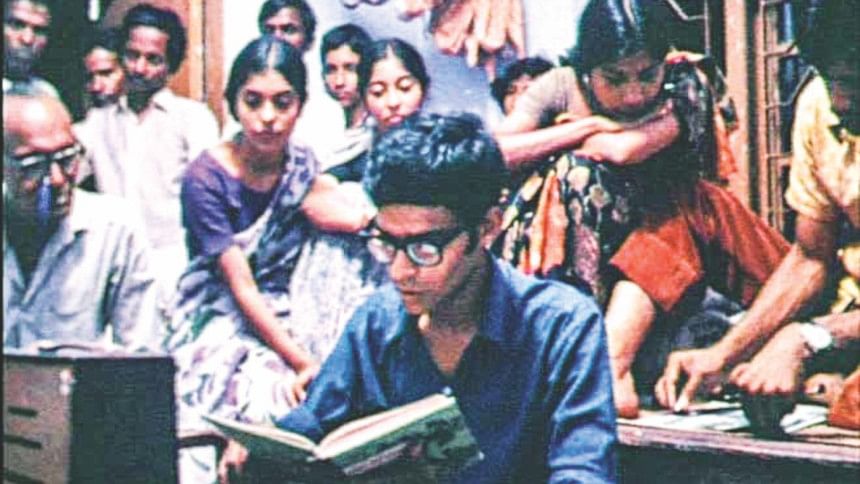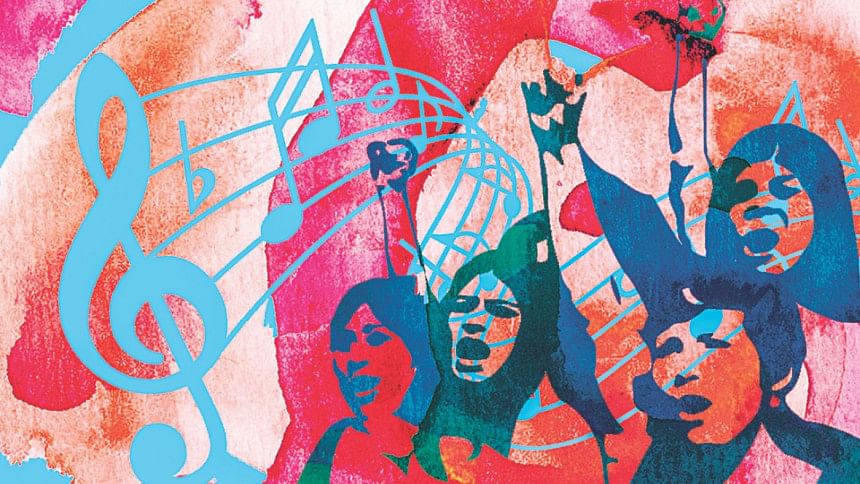We shall overcome

While the public often views the Liberation War and the Language Movement as the apex of protest music in Bangladesh the use of songs to convey political discontent is a long practiced tradition in the subcontinent. Almost every conflict and movement in the region has inspired musical dissent in one form or another, although early technological limitations and governmental restrictions prevented the voice of the common man from being heard. These songs, popularly known as gonosangeet, have evolved over time as new voices have found the right to share their thoughts.
What could be a more appropriate occasion to reflect on them than in February, the month of the Language Movement? Songs like 'Amar bhaier rokte rangano ekushey February' written by Abdul Gaffar Chowdhury and composed by Altaf Mahmud; 'Ora amar mukher bhasha kaira nite chai' and 'rashtrobhasha andolan korilire Bangalee/Dhaka shohor rokte bhashaili' by Abdul Latif capture a spirit of protest, dissent and freedom and have over the years become anthems to the people of this country.

The history of protest songs, however, is older. The idea of using songs as a platform to challenge the establishment first came to a group of left-leaning students of Calcutta University who in 1939 formed the Youth Cultural Institute (YCI). There were no protest songs as such so they vacuumed up Tagore, Nazrul and music from other countries. Kamal Lohani, news editor of the Swadhin Bangla Betar Kendra, a clandestine radio station that mobilised public support for the Liberation War, says, "These are songs created by the people and for the people. They tackled events such as the great famine of '43, the communal riot of '46 and the Partition of '47. A lot of people tend to think that songs of protest must be blunt and sharp. But that's not necessarily true. Protest songs borrowed heavily from Qawwali, Kirtan and folk genres."
Few in the cities then knew that folk singers could sing about issues that related to the real life. In 1945, at an assembly of farmers from all over India in Netrokona, minstrel Rashiduddin Jamshed, an uninvited guest to the programme, spontaneously started singing, "My sorrows know no bounds…Hungry mothers sell their beloved children for food." It was an eye opener for many who thought that minstrels only cared about spiritualism and otherworldliness. Another such song was by Abdul Karim who was a predecessor to Abbasuddin. Set in the Bhatiali tune, it had lines like "The rice produced by the farmer feeds the entire world and yet his stomach is empty."

The forties, in fact, saw the expansion of a cultural movement in Bengal—some had characterised it as 'yet another renaissance' by comparing it with the social reform movement of the nineteenth century. Among the major organisations spearheading this movement were the Progressive Writers Association, Youth Cultural Institute, Indian Peoples' Theatre Association, Friends of Soviet Union Society, Anti-Fascist Writers and Artists Association as well as numerous Bangla literary journals. In 1942 when writer and activist Somen Chanda, born in Narsingdi, was assassinated, the workers of Student Federation organised a gathering at the Calcutta University Institute to protest the killing. Songs of Tagore, Muhammad Iqbal and Subhash Mukhopadhyay were sung with Subhash's 'Raise your voice like thunder' igniting fury in the audience.
Kazi Nazrul Islam was perhaps the first songwriter who saw freedom as not a mere transfer of power but as the total emancipation of the farmer and the worker. He welcomed the Bolshevik revolution of 1917 which dismantled the Tsarist autocracy in Russia by comparing it to an electric summer storm that had to be welcomed by all. No other poet, writer, singer or songwriter has embodied the spirit of dissent better than Nazrul who stands out as the unsurpassed rebel of Bangla literature. Many of his works were banned by the British rulers who imprisoned him in 1922 for a political poem he had written.
If Nazrul was the sun, Hemanga Biswas of Habiganj was the brightest star of people's music in Bengal who drew heavily from the rich genres of folk music in order to make it appeal to the mass. He devoted himself to what he believed in, which was not only the people of Bengal but people of the world. In solidarity with the oppressed everywhere, he composed 'O my Negro Brother' which was based on Subhash Mukhopadhyay's translation of a poem by Nazim Hikmet, Turkish poet, playwright and screenwriter. Hemanga was arrested for his "Mountbatten Mongolkabbya" where he criticised Jawaharlal Nehru, Patel, Abul Kalam Azad, John Mathai and Boldeo Singh for failing to live up to people's expectations in a free country. Salil Chowdhury, on the other hand, was of the view of blending folk tunes with western music to enrich the genre. His song Bicharpati addressed the farcical trials of anti-British rebels and their torture by the police.

"In the post-independence Bangladesh, some people think that we no longer need songs of protest," Kamal Lohani says. "Is that true?"
After the Partition, songs of protest found a fertile land in the erstwhile East Pakistan. "In 1950, on the initiative of artist Nizamul Haque, the "Dhumketu Artists' Association" was formed," says Shamsuzzaman Khan, Director General of Bangla Academy. "Mominul Haque, student leader Gaziul Haque and Altaf Mahmud were associated with it. Their activities had a ripple effect on singer- songwriters in Sylhet, Dhaka, Chittagong, Mymensingh, Comilla and elsewhere. Under the leadership of Montu Khan and Altaf Mahmud "Agrani Artists' Organisation" was founded in Dhaka.
And how songs influenced the Language Movement of 1952 has been discussed briefly earlier. Kalim Sharafi and Chironjib Sharma set up a similar group in Chittagong. Kamal Lohani says, "Poet Abu Bakar Siddiqui, Nazim Mahmud and Akhter Hussain are the pioneers of protest songs in Bangladesh. We turned a few poems of Sikandar Abu Zafar into songs. Sheikh Lutfar Rahman composed the highest number of protest songs."
Today how relevant are these songs—powerful and infectious—designed to be shouted by torrents of marching men and women? More importantly, the premise that songs can fight social injustice—does it still hold water? "In the post-independence Bangladesh, some people think that we no longer need songs of protest," Kamal Lohani says. "Is that true? These songs prepare people for fighting for their rights. Therefore, we can never abandon them even after we have achieved independence. Unfortunately, the growth of this genre of music has stalled over the years. That's because political parties who believe in the spirit of the Liberation War change their character when they go to power. They do not like protest songs. They want songs of praise."
And yet all is not quiet on the singing front. Kamal Lohani says, "Organisations such as Udichi, Gono Sanshkriti Front, Gonoshilpi, Rishij to some extent, and several other small groups are active. Some of them have written and composed songs against the proposed Rampal Power Plant. When the United States invaded Iraq they came up with songs protesting the incursion. But I would say that a situation has arisen where it is becoming increasingly difficult to carry out such cultural activities."
No one argues that we can sing our way through our troubles. But as has been proven time and again, songs can raise "critical consciousness" which focuses on achieving an in-depth understanding of social and political contradictions, and illuminated by that understanding, taking actions against corruption, inequality, violence—our common enemies.
The writer is a member of the Editorial Team.

 For all latest news, follow The Daily Star's Google News channel.
For all latest news, follow The Daily Star's Google News channel. 



Comments